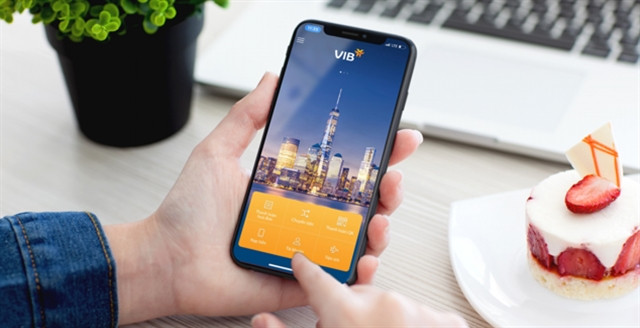 A customer uses VIB’s app. After only six months launching MyVIB 2.0 digital banking application, VIB has doubled the number of customers compared to the previous year. (Photo: thoibaonganhang.vn)
A customer uses VIB’s app. After only six months launching MyVIB 2.0 digital banking application, VIB has doubled the number of customers compared to the previous year. (Photo: thoibaonganhang.vn)After only six months of launching MyVIB 2.0 digital bankingapplication – which uses multi-cloud computing technology to process 60-70% ofthe input data to help banks realise ideas, bring products and services to themarket faster and respond sooner to customer requests, VIB has doubled thenumber of customers compared to the previous year and reach the target of 4million customers nearly a year earlier than expected.
Not only VIB, the wave of “cloudisation” of digital bankingapplications to expand modes and storage capacity, and increase integratedprocessing and user data security capacity has been invested in and implementedby many commercial banks.
Currently, VietABank, PVcomBank, VietinBank, Techcombank, SeABank,ABBank and OCB have all integrated cloud computing technologies to launch new digitalbanking platforms serving the sales of retail products and services, attractingmillions of users.
The business results by the end of 2022 of banks showed a sharpincrease in the number of new customers attracted by banks thanks to theirdigital applications. For example, MB last year added 7 million customers inthe wake of developing Biz MBBank and Charity app while Techcombank withE-Banking apps (using AWS cloud computing technology) attracted anadditional 1.2 million users in 2022. ACB and TPBank also said theyrecorded an annual growth of 30% in the number of customers using digitalapplications in the 2019-2022 period.
Along with the increase in the number of customers, the investmentin new technologies and digitalisation of business activities have helped manybanks attain significant achievements. For VIB and ACB, the proportion ofrevenue from retail activities was around 90% in 2022. Retail activities atother banks such as MB, Techcombank and Sacombank currently account for morethan 50% of their business portfolio.
Recent research by Gimigo Vietnam showed 2023 will continueto witness fierce competition between banks in developing retail digitalbanking applications to gain market share.
According to Gimigo, the group of large State-owned banks such asVietcombank, BIDV, Agribank, VietinBank and MB was leading in the retailsegment thanks to being trusted by users and having a widespread network by theend of 2022. However, the group of private banks such as Techcombank,Sacombank, ACB, VPBank and TPBank have significantly improved their awarenesslevel and attracted a large number of users in recent months.
Gimigo’s survey in Hanoi, Ho Chi Minh City and some other bigcities showed the digital applications of Techcombank, ACB and Sacombank arecurrently competing strongly with large-sized State-owned banks. Other privatebanks such as TPBank and VPBank also have high net promoter scores (NPS). Thus,the group of banks has many opportunities to expand the customer base thanks tothe existing group of loyal customers and the new customers.
According to experts, developing the networks of branches,transaction offices, POS and ATMs is no longer the banks’ top priority.Instead, they focus on digitisation of products and services. To maintain thenumber of customers, banks need to pay more attention to transaction costs,quality of products and services, staff attitude, customer service, andcontinuous improvement of online procedures.
Regarding the development trend of digital application generationsthis year, Gimigo said besides investment in cloud computing technologies andapplying Artificial Intelligence (AI) and Machine Learning to developapplications to support retail sales of products and services, banks will tendto pour in an integrated open banking ecosystem.
Some banks, which have so far invested in purely digital bankingmodels such as Cake, Timo, Tnex, Octo and Ubank, have attracted users. Forexample, VPBank’s Cake app currently has 1 million users.
Experts forecast banks will invest more in developing completelynew digital banking brands in the near future. In which, micro products andservices will be integrated into personal financial management tools to attractcustomers to use banks’ retail products and services./.




























